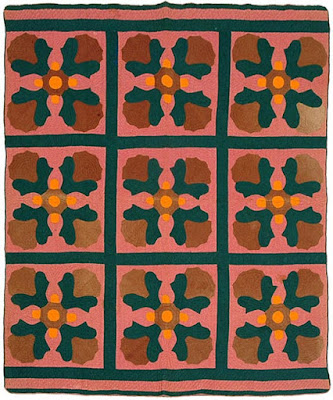Quilt by unknown maker, Thomas County Kansas Historical Society
Until very recently I'd have guessed the date on this quilt to be about 1880-1900. The Turkey red, the beautiful feather quilting---so 19th century. "Late in the 19th century" is indicated by the fading tan
leaves and stems, must once have been green but you often see greens fade to this dun-colored tan after 1880.
Where did she get the pattern?
Conventional Lily
Could it be from Comfort magazine which printed a photo of an almost identical
design in 1928?
1928?
Seems awfully late. But once I started looking at the applique designs published in Comfort in the 1920s I began to see a pattern so to speak. (See yesterday's post on Comfort here:
The quilt was bought at a sale in Yadkin County,
North Carolina, dated by the able North Carolina team as around 1870.
In 1923 the photo of the pattern was mailed to the magazine by Marie H. Carey who called it
Bleeding Heart and said she copied it from "an old Indiana quilt. Coloring: yellow, followed by red, then double green leaves, followed by yellow, topped with red heart-like pieces." The North Carolina quilt attributed to the family of Lola Taylor follows the color suggestions with the exception of the fugitive blue for green.
Now, this may be a question of chicken and egg superseding one another. Did Marie H. Carey photograph the Taylor family quilt? Or did the Taylor family make the quilt after finding the pattern in Comfort in 1923?
Comfort, June, 1928
Surprisingly Comfort, aimed at rural women,
had the largest circulation of any U.S.
magazine in the early 20th century.
I am afraid that I am now leaning towards the idea that the quilts were made after the patterns were published in the 1920s. You might notice my discomfort with these Comfort patterns. If....then... We've been dating these very traditional quilts very wrong.
Here's Lemon Lily or Cockscomb from my Encyclopedia of Applique among two other distinctive Comfort designs.
My drawing is not great
and neither is Mildred Dickerson's from her Comfort scrapbook at the Quilt Research Center at the University of Nebraska Libraries. No date on either sketch. Thanks to Merikay Waldvogel for allowing me to photograph Mildred's Comfort files.
Here is what it is supposed to look like, I guess. Lemon Lily.
From an ebay auction. Apparently she had two dye lots of
red ---one fast and one fugitive. I would not have dated this into the 1920s...
until now.
"Coxcomb variation quilt by Ellen Aycock Jones, ca. 1870s."
McKissick Museum, University of South Carolina
May be time for some revisionist history.
Just how old are these solid color quilts?
Update: Debby K sent this block she worked up into a small piece.
Flowering Almond from Mrs. M M Mitchell in Tennessee in the 1920s.













I love these patterns regardless of the date, but do understand the impact of such information. It's a half century in some cases.
ReplyDeleteFascinating post! A handful of digitized Comfort issues are available here:
ReplyDeletehttps://digital.library.villanova.edu/Item/vudl:304358
I still hold the position that many original appliqué patterns were composed directly from nature by people who were intimately familiar with flora and fauna. As these original patterns spread they became stylized/simplified/personalized. (e.g. Whether the Prince's Feather was inspired by a birds plume or amaranth bloom it morphed into forms far from the original.) The block "Coxcomb variation quilt by Ellen Aycock Jones, ca. 1870s." is a natural and beautifully composed. The Comfort pattern is awkward and, to me, unnatural. My impression that Comfort, rag that it was, used patterns submitted to it by readers. These patterns might be of good quality and attribution or poor 'morphs'. Printed and distributed they were sewn into second or third generation quilts. Their coxcomb and lemon lily block is a poor showing next to the E.A. Jones pattern. I admit my ideas are cut from whole cloth. I enjoy these puzzles.
ReplyDeleteThanks, Glorian I'll check them out.
ReplyDeleteLove learning from your blog. I always wonder when each quilt block came into being. Is there a reference I can look up to do that? or are you it?
ReplyDeleteI actually was told otherwise, that the herpes can not be treated and that there is no way to make it go away once you have it. But I decided to do my own research and found out it is possible to fight it.. I got a lot of information about it here in forums and online,I got Dr Ogala contact on a group were a man from Cordova was sharing his testimony of how he cured him of herpes so I decided to give him a try I emailed him through drogala03@gmail.com . he called me to know if I actually wanted the cured after which the cure was sent to me few days later I was surprised when the same doctor who told me that I was diagnosed of herpes told me that I was completely free from herpes you can reach him through his email drogala03@gmail.com . or through his WhatsApp +2347049668119 if you are diagnosed and also wanna be free from this deadly virus because he is really gonna be of help to you..
ReplyDelete